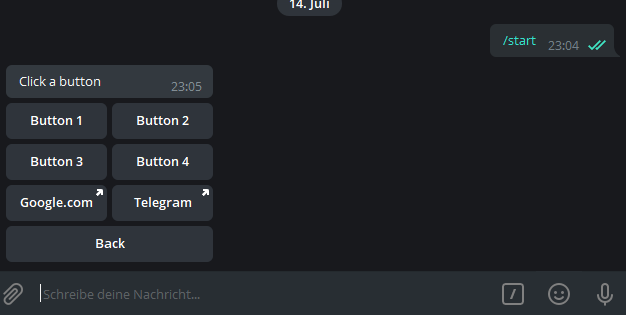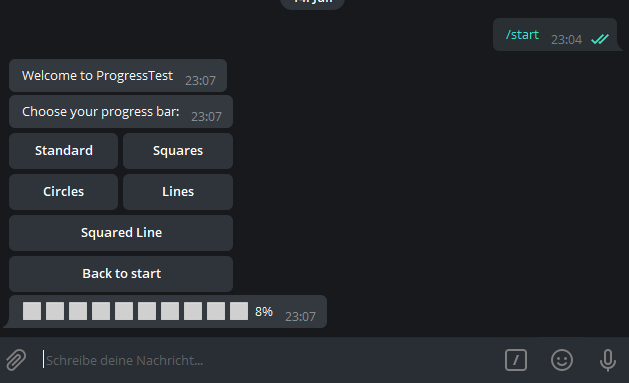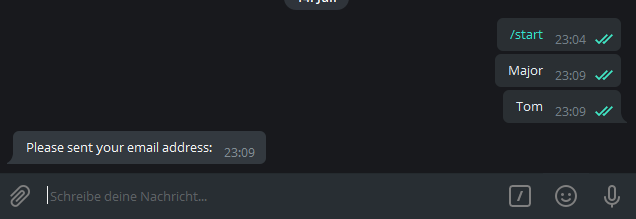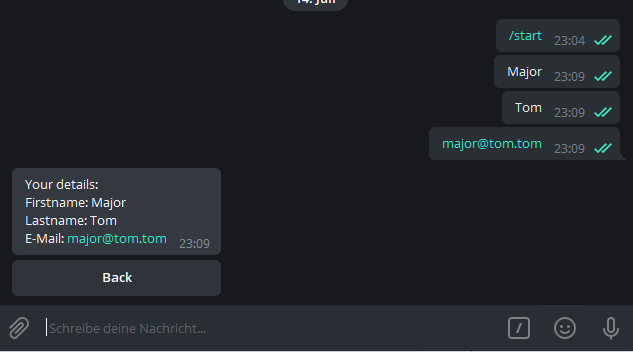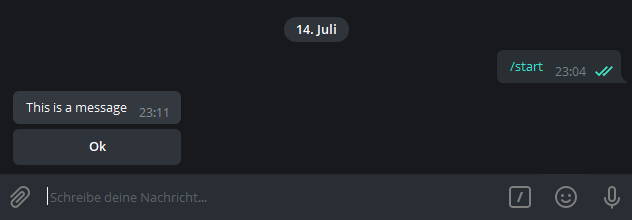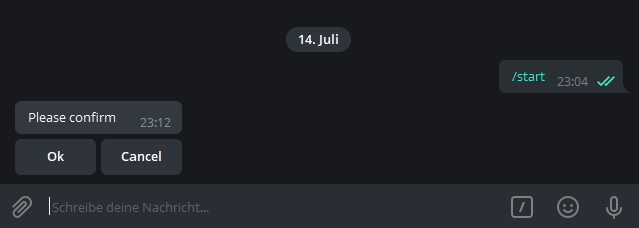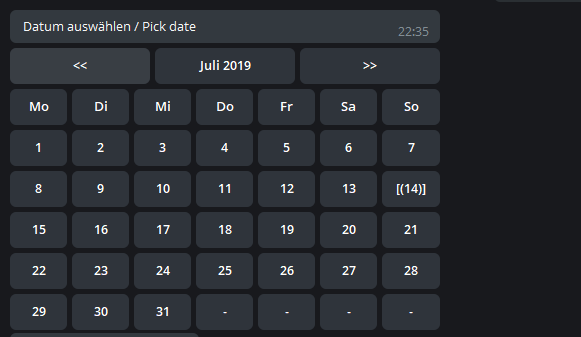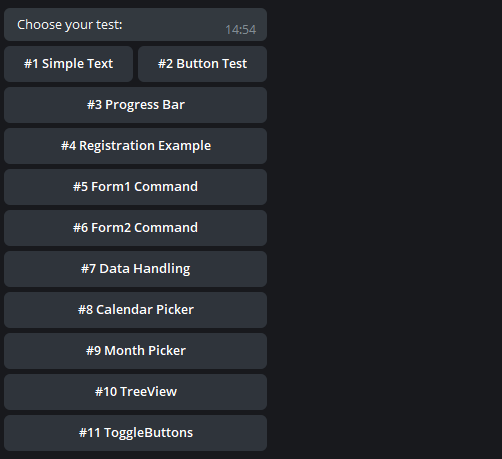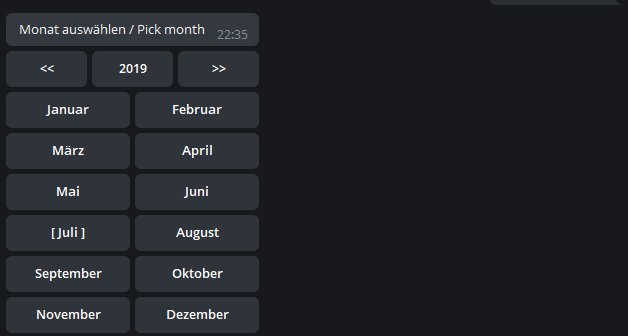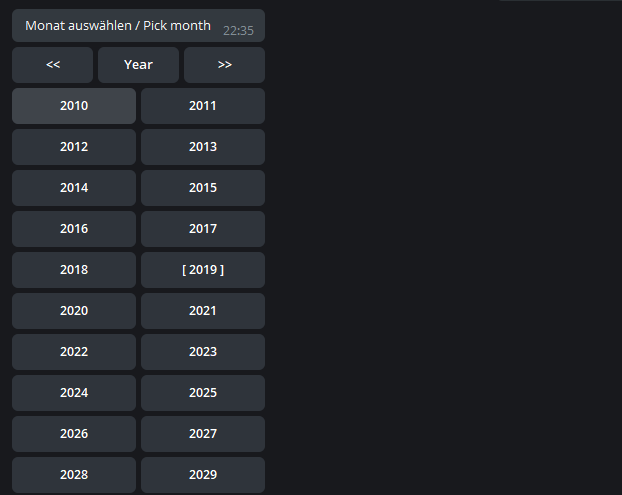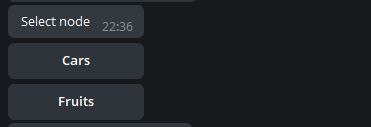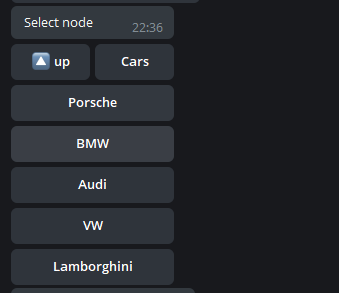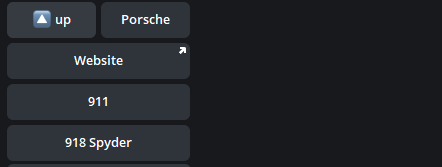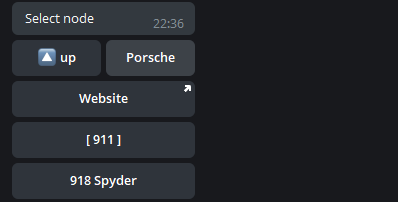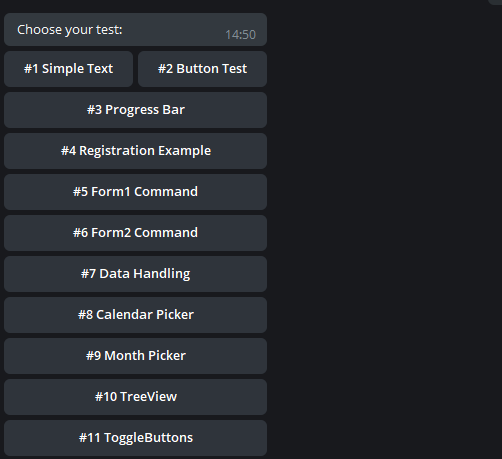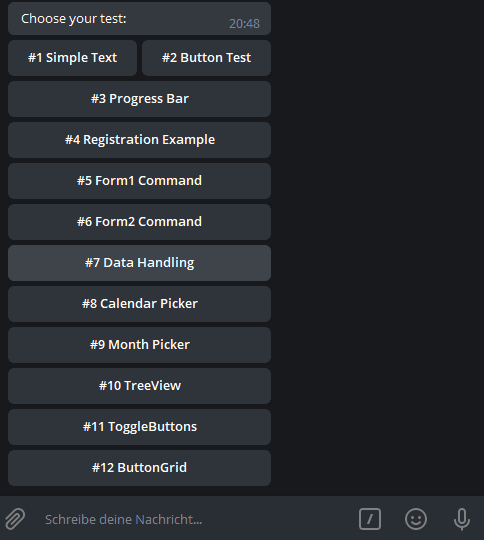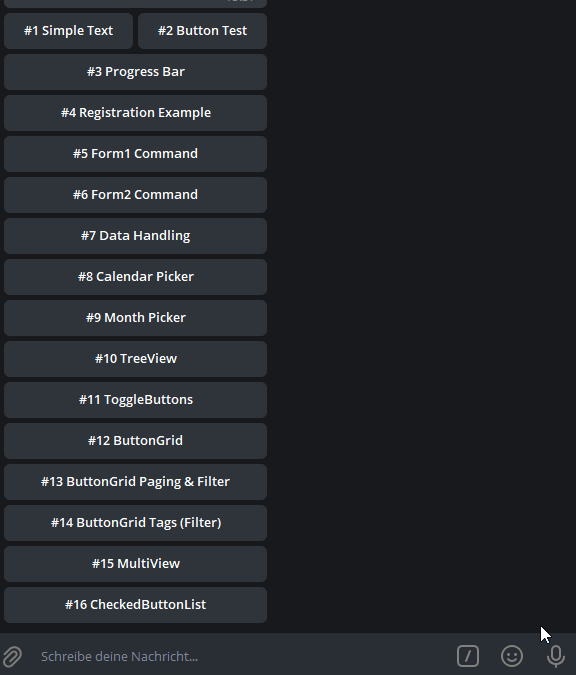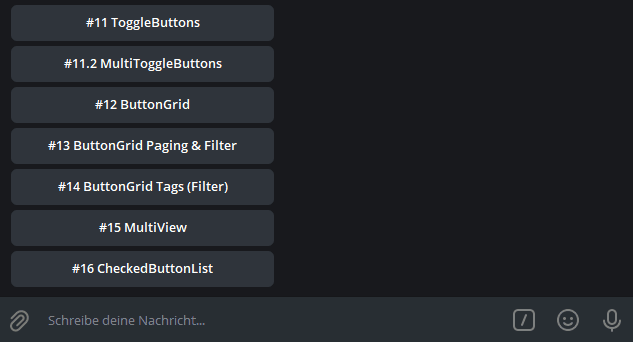Showcase: @TGBaseBot
Support group: @tgbotbase
Releases: GitHub
Bitcoin: 1GoUJYMwAvBipQTfw2FKydAz12J8RDyeJs / bc1qqwlp0p5ley29lsu6jhe0qv7s7963kfc7d0m53d
Etherium: 0xAf3835104c2C3E5b3e721FA2c7365955e87DB931
Litecoin: LRhF1eB7kneFontcDRDU8YjJhEm2GoYHch
Dashcoin: XudiUwWtSmAJj1QDdVW7jocQumJFLsyoGZ
Tron: TYVZSykaVT1nKZnz9hjDgBRNB9VavU1bpW
BitTorrent: TYVZSykaVT1nKZnz9hjDgBRNB9VavU1bpW
- Quick start
- Simplified builder
- Features
- Special Forms
- Controls
- Groups
- State Machine and Session Serialization (v3.0.0)
- Navigation and NavigationController (v4.0.0)
- Extensions
- Examples
First of all, create a new empty dotnet console project and paste some code:
// public async Task Main(string[] args)
var bot = BotBaseBuilder
.Create()
.WithAPIKey("{YOUR API KEY}") // do not store your API key as plain text in project sources
.DefaultMessageLoop()
.WithStartForm<StartForm>()
.NoProxy()
.CustomCommands(a =>
{
a.Start("Starts the bot")
})
.NoSerialization()
.UseEnglish()
.Build();
// Upload bot commands to BotFather
await bot.UploadBotCommands();
// Start your Bot
bot.Start();The BotBase class will manage a lot of things for you, like bot commands, action events and so on.
StartForm is your first form which every user will get internally redirected to, just like a start page.
It needs to be a subclass of FormBase you will find in namespace TelegramBotBase.Base
Every Form has some events which will get raised at specific times. On every form you are able to get notes about
the Remote Device,
like ChatId and other stuff your carrying. From there you build up your bots:
public class StartForm : FormBase
{
// Gets invoked during Navigation to this form
public override async Task PreLoad(MessageResult message)
{
}
// Gets invoked on every Message/Action/Data in this context
public override async Task Load(MessageResult message)
{
// `Device` is a wrapper for current chat - you can easily respond to the user
await this.Device.Send("Hello world!");
}
// Gets invoked on edited messages
public override async Task Edited(MessageResult message)
{
}
// Gets invoked on Button clicks
public override async Task Action(MessageResult message)
{
}
// Gets invoked on Data uploades by the user (of type Photo, Audio, Video, Contact, Location, Document)
public override async Task SentData(DataResult data)
{
}
//Gets invoked on every Message/Action/Data to render Design or Response
public override async Task Render(MessageResult message)
{
}
}Send a message after loading a specific form:
await this.Device.Send("Hello world!");Want to go to a different form? Go ahead, create it, initialize it and navigate to it:
var form = new TestForm();
await this.NavigateTo(form);When migrating from a previous version or starting completely new, all these options can be a bit overwhelming.
There's a function called QuickStart that simplifies building a bit.
var bot = BotBaseBuilder
.Create()
.QuickStart<StartForm>("{YOUR API KEY}")
.Build();
bot.Start();Using BotFather you can add Commands to your bot. The user will see them as popups in a dialog. Before start (and later for sure) you could add them to your BotBase. If the message contains a command, a special event handler will get raised.
Below we have 4 commands.
/start - opens the start form
/form1 - navigates in this context to form1
/form2 - navigates in this context to form2
/params - demonstrates the use of parameters per command (i.e. /params 1 2 3 test ...)
var bot = BotBaseBuilder
.Create()
.WithAPIKey("{YOUR API KEY}")
.DefaultMessageLoop()
.WithStartForm<Start>()
.NoProxy()
.CustomCommands(a =>
{
a.Start("Starts the bot");
a.Add("form1","Opens test form 1" );
a.Add("form2", "Opens test form 2" );
a.Add("params", "Returns all send parameters as a message." );
})
.NoSerialization()
.UseEnglish()
.Build();
bot.BotCommand += async (s, en) =>
{
switch (en.Command)
{
case "/form1":
var form1 = new TestForm();
await en.Device.ActiveForm.NavigateTo(form1);
break;
case "/form2":
var form2 = new TestForm2();
await en.Device.ActiveForm.NavigateTo(form2);
break;
case "/params":
string m = en.Parameters.DefaultIfEmpty("").Aggregate((a, b) => a + " and " + b);
await en.Device.Send("Your parameters are " + m, replyTo: en.Device.LastMessage);
break;
}
};
await bot.UploadBotCommands()
bot.Start();On every input the user is sending back to the bot, the Action event gets raised. So here we could manage to send
something back to him.
public class SimpleForm : AutoCleanForm
{
public SimpleForm()
{
this.DeleteSide = TelegramBotBase.Enums.eDeleteSide.Both;
this.DeleteMode = TelegramBotBase.Enums.eDeleteMode.OnLeavingForm;
this.Opened += SimpleForm_Opened;
}
private async Task SimpleForm_Opened(object sender, EventArgs e)
{
await this.Device.Send("Hello world! (send 'back' to get back to Start)\r\nOr\r\nhi, hello, maybe, bye and ciao");
}
public override async Task Load(MessageResult message)
{
// message.MessageText will work also, cause it is a string you could manage a lot different scenerios here
var messageId = message.MessageId;
switch (message.Command)
{
case "hello":
case "hi":
// Send a simple message
await this.Device.Send("Hello you there !");
break;
case "maybe":
// Send a simple message and reply to the one of himself
await this.Device.Send("Maybe what?", replyTo: messageId);
break;
case "bye":
case "ciao":
// Send a simple message
await this.Device.Send("Ok, take care !");
break;
}
}
}public class ButtonTestForm : AutoCleanForm
{
public override async Task Opened()
{
await this.Device.Send("Hello world! (Click 'back' to get back to Start)");
}
public override async Task Action(MessageResult message)
{
var call = message.GetData<CallbackData>();
await message.ConfirmAction();
if (call == null)
return;
message.Handled = true;
switch (call.Value)
{
case "button1":
await this.Device.Send("Button 1 pressed");
break;
case "button2":
await this.Device.Send("Button 2 pressed");
break;
case "button3":
await this.Device.Send("Button 3 pressed");
break;
case "button4":
await this.Device.Send("Button 4 pressed");
break;
case "back":
var st = new Start();
await this.NavigateTo(st);
break;
default:
message.Handled = false;
break;
}
}
public override async Task Render(MessageResult message)
{
ButtonForm btn = new ButtonForm();
btn.AddButtonRow(new ButtonBase("Button 1", new CallbackData("a", "button1").Serialize()), new ButtonBase("Button 2", new CallbackData("a", "button2").Serialize()));
btn.AddButtonRow(new ButtonBase("Button 3", new CallbackData("a", "button3").Serialize()), new ButtonBase("Button 4", new CallbackData("a", "button4").Serialize()));
btn.AddButtonRow(new ButtonBase("Google.com", "google", "https://www.google.com"), new ButtonBase("Telegram", "telegram", "https://telegram.org/"));
btn.AddButtonRow(new ButtonBase("Back", new CallbackData("a", "back").Serialize()));
await this.Device.Send("Click a button", btn);
}
}There are a bunch of ready to use controls. For example, progress bar.
public class ProgressTest : AutoCleanForm
{
public ProgressTest()
{
this.DeleteMode = eDeleteMode.OnLeavingForm;
}
public override async Task Opened()
{
await this.Device.Send("Welcome to ProgressTest");
}
public override async Task Action(MessageResult message)
{
var call = message.GetData<CallbackData>();
await message.ConfirmAction();
if (call == null) return;
TelegramBotBase.Controls.ProgressBar Bar = null;
switch (call.Value)
{
case "standard":
Bar = new TelegramBotBase.Controls.ProgressBar(0, 100, TelegramBotBase.Controls.ProgressBar.eProgressStyle.standard);
Bar.Device = this.Device;
break;
case "squares":
Bar = new TelegramBotBase.Controls.ProgressBar(0, 100, TelegramBotBase.Controls.ProgressBar.eProgressStyle.squares);
Bar.Device = this.Device;
break;
case "circles":
Bar = new TelegramBotBase.Controls.ProgressBar(0, 100, TelegramBotBase.Controls.ProgressBar.eProgressStyle.circles);
Bar.Device = this.Device;
break;
case "lines":
Bar = new TelegramBotBase.Controls.ProgressBar(0, 100, TelegramBotBase.Controls.ProgressBar.eProgressStyle.lines);
Bar.Device = this.Device;
break;
case "squaredlines":
Bar = new TelegramBotBase.Controls.ProgressBar(0, 100, TelegramBotBase.Controls.ProgressBar.eProgressStyle.squaredLines);
Bar.Device = this.Device;
break;
case "start":
var sf = new Start();
await sf.Init();
await this.NavigateTo(sf);
return;
default:
return;
}
// Render Progress bar and show some "example" progress
await Bar.Render();
this.Controls.Add(Bar);
for (int i = 0; i <= 100; i++)
{
Bar.Value++;
await Bar.Render();
Thread.Sleep(250);
}
}
public override async Task Render(MessageResult message)
{
ButtonForm btn = new ButtonForm();
btn.AddButtonRow(new ButtonBase("Standard", new CallbackData("a", "standard").Serialize()), new ButtonBase("Squares", new CallbackData("a", "squares").Serialize()));
btn.AddButtonRow(new ButtonBase("Circles", new CallbackData("a", "circles").Serialize()), new ButtonBase("Lines", new CallbackData("a", "lines").Serialize()));
btn.AddButtonRow(new ButtonBase("Squared Line", new CallbackData("a", "squaredlines").Serialize()));
btn.AddButtonRow(new ButtonBase("Back to start", new CallbackData("a", "start").Serialize()));
await this.Device.Send("Choose your progress bar:", btn);
}
public override async Task Closed()
{
foreach (var b in this.Controls)
{
await b.Cleanup();
}
await this.Device.Send("Ciao from ProgressTest");
}
}Registration forms have never been so easy.
public class PerForm : AutoCleanForm
{
public string EMail { get; set; }
public string Firstname { get; set; }
public string Lastname { get; set; }
public async override Task Load(MessageResult message)
{
if (string.IsNullOrWhiteSpace(message.MessageText)) return;
if (this.Firstname == null)
{
this.Firstname = message.MessageText;
return;
}
if (this.Lastname == null)
{
this.Lastname = message.MessageText;
return;
}
if (this.EMail == null)
{
this.EMail = message.MessageText;
return;
}
}
public async override Task Action(MessageResult message)
{
var call = message.GetData<CallbackData>();
await message.ConfirmAction();
if (call == null) return;
switch (call.Value)
{
case "back":
var start = new Start();
await this.NavigateTo(start);
break;
}
}
public async override Task Render(MessageResult message)
{
if (this.Firstname == null)
{
await this.Device.Send("Please sent your firstname:");
return;
}
if (this.Lastname == null)
{
await this.Device.Send("Please sent your lastname:");
return;
}
if (this.EMail == null)
{
await this.Device.Send("Please sent your email address:");
return;
}
string s = "";
s += "Firstname: " + this.Firstname + "\r\n";
s += "Lastname: " + this.Lastname + "\r\n";
s += "E-Mail: " + this.EMail + "\r\n";
ButtonForm bf = new ButtonForm();
bf.AddButtonRow(new ButtonBase("Back", new CallbackData("a", "back").Serialize()));
await this.Device.Send("Your details:\r\n" + s, bf);
}
}Another case, where every of these 3 inputs gets requested by a different forms. Just for imagination of the possibilities.
There are some default forms to make the interaction with users easier.
-
AlertDialog Just a simple dialog with one Button.
-
AutoCleanForm A form which needs to be derived from. It will be delete all in the context sent messages to the user after every new message or on leaving the form and navigates somewhere else. Makes sense to create a feeling of a clean environment for the user. For instance if you have a multilevel menu. This will remove the previously shown menu, and renders the new sub/top level.
-
PromptDialog A simple dialog which will show a message and then wait for a text input (response).
-
ConfirmDialog A simple dialog which is able to show multiple buttons and a text message. The user could select one option and will get redirected to a different form, depending on the click.
AlertDialog ad = new AlertDialog("This is a message", "Ok");
ad.ButtonClicked += async (s, en) =>
{
var fto = new TestForm2();
await this.NavigateTo(fto);
};
await this.NavigateTo(ad);Just try it by youself.
PromptDialog pd = new PromptDialog("Please tell me your name ?");
pd.Completed += async (s, en) =>
{
await this.Device.Send("Hello " + pd.Value);
};
await this.OpenModal(pd);ConfirmDialog cd = new ConfirmDialog("Please confirm", new ButtonBase("Ok", "ok"), new ButtonBase("Cancel", "cancel"));
cd.ButtonClicked += async (s, en) =>
{
var tf = new TestForm2();
// Remember only to navigate from the current running form. (here it is the prompt dialog, cause we have left the above already)
await cd.NavigateTo(tf);
};
await this.NavigateTo(cd);For groups, there are multiple different tools which helps to work with and allows bot also to manage "Single-User" chats and group chats.
An easy way to switch between a Single-User form and one for managing a group is the SplitterForm base class. It calls special methods which you can override and then move from there to the form you need.
The OpenGroup method is the backup if OpenChannel or OpenSupergroup is not overridden. Same for Open, it is "backup" if none of the previous methods has been overridden.
public class Start : SplitterForm
{
public override async Task<bool> Open(MessageResult e)
{
var st = new Menu();
await this.NavigateTo(st);
return true;
}
public override async Task<bool> OpenGroup(MessageResult e)
{
var st = new Groups.LinkReplaceTest();
await this.NavigateTo(st);
return true;
}
public override Task<bool> OpenChannel(MessageResult e)
{
return base.OpenChannel(e);
}
public override Task<bool> OpenSupergroup(MessageResult e)
{
return base.OpenSupergroup(e);
}
}For managing groups there's a base class called GroupForm. This one has special events which should make it
easier to work with groups and channels.
In the Example project there's a simple example for deleting an url written by a user and incrementing an internal
counter. At
every url he writes he gets blocked for a small amount of time and the message gets deleted. At 3 failures, the user
gets
kicked of the group and blocked.
public class GroupForm : FormBase
{
public override async Task Load(MessageResult message)
{
switch (message.MessageType)
{
case Telegram.Bot.Types.Enums.MessageType.ChatMembersAdded:
await OnMemberChanges(new MemberChangeEventArgs(Telegram.Bot.Types.Enums.MessageType.ChatMembersAdded, message, message.RawMessageData.Message.NewChatMembers));
break;
case Telegram.Bot.Types.Enums.MessageType.ChatMemberLeft:
await OnMemberChanges(new MemberChangeEventArgs(Telegram.Bot.Types.Enums.MessageType.ChatMemberLeft, message, message.RawMessageData.Message.LeftChatMember));
break;
case Telegram.Bot.Types.Enums.MessageType.ChatPhotoChanged:
case Telegram.Bot.Types.Enums.MessageType.ChatPhotoDeleted:
case Telegram.Bot.Types.Enums.MessageType.ChatTitleChanged:
case Telegram.Bot.Types.Enums.MessageType.MigratedFromGroup:
case Telegram.Bot.Types.Enums.MessageType.MigratedToSupergroup:
case Telegram.Bot.Types.Enums.MessageType.MessagePinned:
case Telegram.Bot.Types.Enums.MessageType.GroupCreated:
case Telegram.Bot.Types.Enums.MessageType.SupergroupCreated:
case Telegram.Bot.Types.Enums.MessageType.ChannelCreated:
await OnGroupChanged(new GroupChangedEventArgs(message.MessageType, message));
break;
default:
OnMessage(message);
break;
}
}
public virtual async Task OnMemberChanges(MemberChangeEventArgs e)
{
}
public virtual async Task OnGroupChanged(GroupChangedEventArgs e)
{
}
public virtual async Task OnMessage(MessageResult e)
{
}
}Depending on the use-cases and the overall structure of a Telegram Bot it is essential to have some kind of session serialization or state machine to keep the user context after bot restarts (i.e. due to updates) or crashes. For this we have some structures which fits into the current environment.
There are actually 3 types of example state machines you could use. A state machine is a kind of serializer which saves the important session data in a reusable structure like JSON or XML.
Is easy to use and useful for simple structures like basic datatypes. Won't work for complex ones like generics.
var bot = BotBaseBuilder
.Create()
.WithAPIKey("{YOUR API KEY}")
.DefaultMessageLoop()
.WithStartForm<StartForm>()
.NoProxy()
.CustomCommands(a =>
{
a.Start("Starts the bot");
})
.UseSimpleJSON(AppContext.BaseDirectory + "config\\states.json")
.UseEnglish()
.Build();
bot.Start();Is easy to use too, but works for complex datatypes, because it saves there namespaces and additional type info into the JSON file too.
var bot = BotBaseBuilder
.Create()
.WithAPIKey("{YOUR API KEY}")
.DefaultMessageLoop()
.WithStartForm<StartForm>()
.NoProxy()
.CustomCommands(a =>
{
a.Start("Starts the bot");
})
.UseJSON(AppContext.BaseDirectory + "config\\states.json")
.UseEnglish()
.Build();
bot.Start();The last one, should work like the others.
var bot = BotBaseBuilder
.Create()
.WithAPIKey("{YOUR API KEY}")
.DefaultMessageLoop()
.WithStartForm<StartForm>()
.NoProxy()
.CustomCommands(a =>
{
a.Start("Starts the bot");
})
.UseXML(AppContext.BaseDirectory + "config\\states.xml")
.UseEnglish()
.Build();
bot.Start();There are two interfaces, one for the StateMachine itself, which is useful to build a custom one for a different datatype and one for implementing into a form which should be invoked with events.
Is the basic StateMachine interface, it has two methods SaveFormStates(SaveStatesEventArgs e)
and StateContainerLoadFormStates(), nothing fancy, just simple calls. Implement both methods with your own
serialization process.
public interface IStateMachine
{
void SaveFormStates(SaveStatesEventArgs e);
StateContainer LoadFormStates();
}When implemented, this will invoke one of these two methods: LoadState(LoadStateEventArgs e)
or SaveState(SaveStateEventArgs e).
They have methods to load or save data from the statemachine of the current form.
public interface IStateForm
{
void LoadState(LoadStateEventArgs e);
void SaveState(SaveStateEventArgs e);
}If you don't want to implement the IStateForm interface, because there are maybe just one or two properties you want
to
keep and restore, use the following attributes.
This will let the engine know, that you want too keep and restore this field automatically. Unlike the IStateForm methods, you have no option to manipulate data.
[SaveState]
public long UserId { get; set; }Due to the fact that Attribute implementation and interaction is optional, you want to let the engine maybe know, that you don't want to keep a specific form. So it should get lost. This attribute will help you here, add it to the form class and it will not get serialized, even if it implements IStateForm or the SaveState attributes.
[IgnoreState]
public class Registration : STForm
{
}As from earlier topics on this readme you already know the default way for (cross) navigation between Forms. It will look something like this:
var f = new FormBase();
await this.NavigateTo(f);Depending on the model and structure of your bot it can make sense, to have more linear navigation instead of cross navigation.
For example, you have a bot which shows a list of football teams. And when clicking on it you want to open the team details and latest matches.
After the matches, you want to maybe switch to different teams and take a look at their statistics and matches.
At some point, you just want to get back to the first team so like on Android you're clicking the "back" button multiple times.
This can become really complicated, when not having some controller below which handle these "Push/Pop" calls.
Thats why we hace a NavigationController class which manages these situations and the stack.
First, you need to create a NavigationController instance at the same position in code, where you want to start the navigation.
You will use the current FormBase instance as a root class within the constructor, so you can later come back to this one.
Tip: You can add also a completely new instance of i.e. a main menu form here to get back to it then. So you are free to choose.
We are using the same FormBase instance as above.
var nc = new NavigationController(this);
var f = new FormBase();
// Replace the current form in the context with the controller.
await this.NavigateTo(nc);
// Push the new from onto the stack to render it
nc.PushAsync(f);Later to open a new form use PushAsync again:
await this.NavigationController.PushAsync(newForm);When you want to go back one Form on the stack use PopAsync:
await this.NavigationController.PopAsync();Notice: By default the NavigationController has ForceCleanupOnLastPop enabled, which means that when the stack
is
again at 1 (due to PopAsync or PopToRootAsync calls) it will replace the controller automatically with the root form
you
have given to the constructor at the beginning.
Extends the base package with some additional image methods like SendPhoto (using Bitmap)
https://www.nuget.org/packages/TelegramBotBase.Extensions.Images/
A session serializer for Microsoft SQL Server.
https://www.nuget.org/packages/TelegramBotBase.Extensions.Serializer.Database.MSSQL/
You can find all example projects in the "Examples" subfolder.
Will allow you to run specific system commands or run/kill processes via Bot. Also has a simple authentication mechanism with one password.
Example using minimal dotnet console template with EntityFramework and Dependency Injection.
Will delete Join and Leave messages automatically in groups.
When you want to update forms async without any user interaction (message/action) before. Use the new InvokeMessageLoop method of BotBase.





